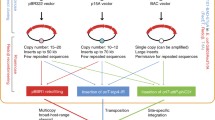Abstract
A large cassette, 4.6 × 103 bases (4.6 kb) in length, containing an inducible expression system (the yeast CUP1 promoter fused to the Escherichia coli lacZ structural gene) and a bacterial neomycin-resistance gene (neo) has been cloned into the noncoding region of a GAL1-regulated Ty1 retrotransposon. Galactose was used to induce retrotransposition in Saccharomyces cerevisiae, and cells containing integrations were selected by resistance to the aminoglycoside G418. Integrations of neo and CUP1p-lacZ were verified, and β-galactosidase activity was confirmed. Analysis via Southern blots demonstrated integrations at various chromosomal locations, and the number of insertions obtained ranged from one to five after three rounds of induction. Therefore, the packaging limit of Ty1 virus-like particles for RNA is at least 10.3 kb and Ty1 can transpose foreign genes as large as 4.6 kb, demonstrating the practical application of Ty1 for the insertion of large regulated expression cassettes.
Similar content being viewed by others
References
Boeke JD (1989) Transposable elements in Saccharomyces cerevisiae. In: Berg DE, Howe MM (eds) Mobile DNA. American Society of Microbiology, Washington DC, pp 335–374
Boeke JD, Sandmeyer SB (1991) Yeast transposable elements. In: Broach JR, Jones EW, Pringle J (eds) The molecular and cellular biology of the yeast Saccharomyces: genome dynamics, protein synthesis, and energetics, vol 1. Cold Spring Harbor Laboratory Press, Cold Spring Harbor, New York, pp 193–261
Boeke JD, LaCroute F, Fink GR (1984) A positive selection for mutants lacking orotidine-5′-phosphate decarboxylase activity in yeast: 5-fluoro-orotic acid resistance. Mol Gen Genet 197:345–346
Boeke JD, Garfinkel DJ, Styles CA, Fink GR (1985) Ty elements transpose through an RNA intermediate. Cell 40:491–500
Boeke JD, Styles CA, Fink GR (1986) Saccharomyces cerevisiae SPT3 gene is required for transposition and transpositional recombination of chromosomal Ty elements. Mol Cell Biol 6:3575–3581
Boeke JD, Xu H, Fink GR (1988) A general method for the chromosomal amplification of genes in yeast. Science 239:280–282
Boeke JD, Eichinger DJ, Natsoulis G (1991) Doubling Ty1 element copy number in Saccharomyces cerevisiae: host genome stability and phenotypic effects. Genetics 129:1043–1052
Cameron RR, Loh EY, Davis RW (1979) Evidence for transposition of dispersed repetitive DNA families in yeast. Cell 16:739–751
Durrin LK, Mann RK, Kayne PS, Grunstein M (1991) Yeast histone H4 N-terminal sequence is required for promoter activation in vivo. Cell 65:1023–1031
Garfinkel DJ, Mastrangelo MF, Sanders NJ, Shafer BK, Strathern JN (1988) Transposon tagging using Ty elements in yeast. Genetics 120:95–108
Gietz RD, Sugino A (1988) New yeast-Escherichia coli shuttle vectors constructed with in vitro mutagenized yeast genes lacking six-base restriction sites. Gene 74:527–534
Ito H, Fukuda Y, Murata K, Kimura A (1983) Transformation of intact yeast cells treated with alkali cations. J Bacteriol 153: 163–168
Jacobs E, Dewerchin M, Boeke JD (1988) Retrovirus-like vectors for Saccharomyces cerevisiae: integration of foreign genes controlled by efficient promoters into yeast chromosomal DNA. Gene 67:259–269
Ji H, Moore DP, Blomberg MA, Braiterman LT, Voytas DF, Natsoulis G, Boeke JD (1993) Hotspots for unselected Ty1 transposition events on yeast chromosome III are near tRNA genes and LTR sequences. Cell 73:1007–1018
Jimenez A, Davies J (1980) Expression of a transposable antibiotic resistance element in Saccharomyces cerevisiae: a potential selection for eukaryotic cloning vectors. Nature 287:869–871
Joyce CM, Grindley NDF (1984) Methods of determining whether a gene of Escherichia coli is essential: application to the polA gene. J Bacteriol 158:636–643
Kirchner J, Sandmeyer SB (1993) Proteolytic processing of Ty3 proteins is required for transposition. J Virol 67:19–28
Sambrook J, Fritsch EF, Maniatis T (1989) Molecular cloning: a laboratory manual, 2nd edn. Cold Spring Harbor Laboratory Press, Cold Spring Harbor, New York
Sherman F, Fink GR, Hicks JB (1986) Methods in yeast genetics. Cold Spring Harbor Laboratory Press, Cold Spring Harbor, New York
Wang Z, Da Silva NA (1993) Analysis of X-gal plates for quantitative plasmid stability determinations in Saccharomyces cerevisiae. Biotechnol Tech 7:325–328
Xu H, Boeke JD (1987) High frequency deletion between homologous sequences during retrotransposition of Ty elements in Saccharomyces cerevisiae. Proc Natl Acad Sci USA 84:8553–8557
Author information
Authors and Affiliations
Rights and permissions
About this article
Cite this article
Lee, F.W.F., De Silva, N.A. Application of Ty1 for cloned gene insertion: amplification of a large regulated expression cassette in Saccharomyces cerevisiae . Appl Microbiol Biotechnol 44, 620–623 (1996). https://doi.org/10.1007/BF00172494
Received:
Revised:
Accepted:
Issue Date:
DOI: https://doi.org/10.1007/BF00172494




